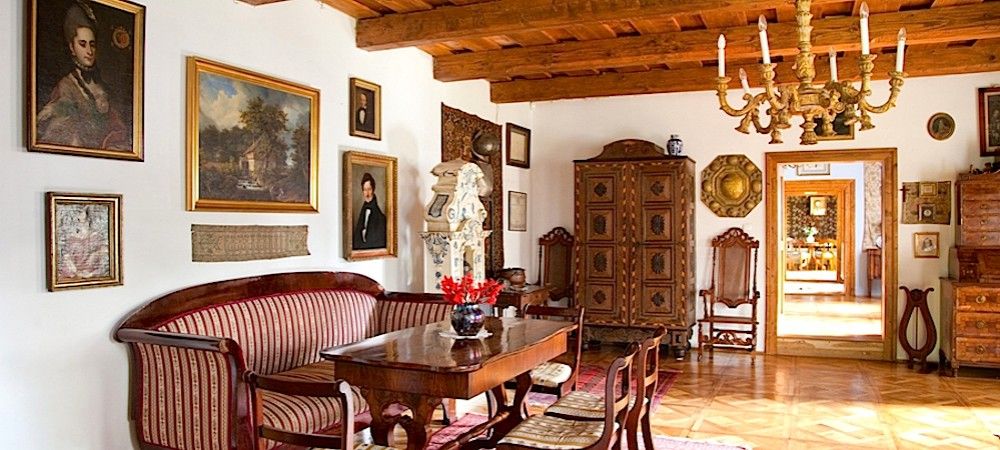
Kopytowa
The village is known for its magnificent and unique Museum of Nobility Culture, established in a fortuitously saved old residence from the turn of the 19th century.
Kopytowa is a small village beautifully integrated into the hilly landscape around fifteen kilometres to the west of Krosno. It is one of the oldest settlements in the area, first mentioned in a document from 1227 as the property of the Cisterian Order monastery in Koprzywnica. After the first Partition of Poland, the village was taken over by the Austrians and put on sale after the abolition of the monastery in 1783. It was bought in 1799 by Mikołaj Kotarski of the Pnieja coat of arms, who renovated the old Cisterian manor house. The house was then remodelled several times by the Kotarski and the Brzeski family, but after the Second World War it fell into complete disrepair and ended up as a barn.
When it seemed that the manor house in Kopytowa would be another memento of Polish nobility culture to fade into oblivion, an enthusiast came along who was able to notice the old glory in the sad ruin. It was Andrzej Kołder, a collector and enthusiast of history from Krosno, who became interested in the building in 1996, and for the next 10 years did not spare any effort nor expense to renovate it. Based on old designs, the original appearance of the manor was restored in around 80 per cent, not just from before devastation, but also from before the inept remodelling works. The devastated park was also brought back to life, and the old driveway and lawn were restored. It is not surprising then that the effort was rewarded with the “Well-kempt Monument” title by the Minister of Culture and National Heritage.
The museum is one of the few places which have preserved the Sarmatian spirit of old Polish nobility culture. It is manifest in the carefully designed interiors, where every detail has its place. Thanks to the present owner’s passion for collecting, the bare rooms have been filled with historic furniture, paintings and ornate valuables and heirlooms.
The interiors were made available to visitors on 30 April 2011, with the opening of the Museum of Nobility Culture, which presents the old Sarmatian culture. Apart from admiring the original furnishings of the rooms, dated from the end of the 18th century to the widely represented 19th century Biedermeier style, visitors can listen to the interesting history of the place told by the unusual host.
The spacious living room is a testament to its designer’s knowledge and taste. It draws the visitors’ attention with stately Biedermeier sofas, a massive Baroque wardrobe with intricate intarsia ornaments, a Classicist secretaire, and a unique Baroque tile stove. The decoration of the room is complemented by the portraits of nobility, Oriental carpets and elements of armour hanging on the walls. Other rooms include the old study of the lord of the manor, the dining room, the bedroom and kitchen. Each of the rooms was carefully reconstructed, and none of the items you will see there is a modern replica. The old Cistercian traditions are remembered in the interactive gingerbread workshop with an original programme for children and teenagers aiming to develop creativity and imagination. It involves, among other things, creative workshops in designing and making various forms of gingerbread, including gingerbread ornaments.
fot.: arch. Muzeum Kultury Szlacheckiej
When it seemed that the manor house in Kopytowa would be another memento of Polish nobility culture to fade into oblivion, an enthusiast came along who was able to notice the old glory in the sad ruin. It was Andrzej Kołder, a collector and enthusiast of history from Krosno, who became interested in the building in 1996, and for the next 10 years did not spare any effort nor expense to renovate it. Based on old designs, the original appearance of the manor was restored in around 80 per cent, not just from before devastation, but also from before the inept remodelling works. The devastated park was also brought back to life, and the old driveway and lawn were restored. It is not surprising then that the effort was rewarded with the “Well-kempt Monument” title by the Minister of Culture and National Heritage.
The museum is one of the few places which have preserved the Sarmatian spirit of old Polish nobility culture. It is manifest in the carefully designed interiors, where every detail has its place. Thanks to the present owner’s passion for collecting, the bare rooms have been filled with historic furniture, paintings and ornate valuables and heirlooms.
The interiors were made available to visitors on 30 April 2011, with the opening of the Museum of Nobility Culture, which presents the old Sarmatian culture. Apart from admiring the original furnishings of the rooms, dated from the end of the 18th century to the widely represented 19th century Biedermeier style, visitors can listen to the interesting history of the place told by the unusual host.
The spacious living room is a testament to its designer’s knowledge and taste. It draws the visitors’ attention with stately Biedermeier sofas, a massive Baroque wardrobe with intricate intarsia ornaments, a Classicist secretaire, and a unique Baroque tile stove. The decoration of the room is complemented by the portraits of nobility, Oriental carpets and elements of armour hanging on the walls. Other rooms include the old study of the lord of the manor, the dining room, the bedroom and kitchen. Each of the rooms was carefully reconstructed, and none of the items you will see there is a modern replica. The old Cistercian traditions are remembered in the interactive gingerbread workshop with an original programme for children and teenagers aiming to develop creativity and imagination. It involves, among other things, creative workshops in designing and making various forms of gingerbread, including gingerbread ornaments.
fot.: arch. Muzeum Kultury Szlacheckiej
Additional information: Telephone booking: +48 788 837 412 or +48 888 959 661
